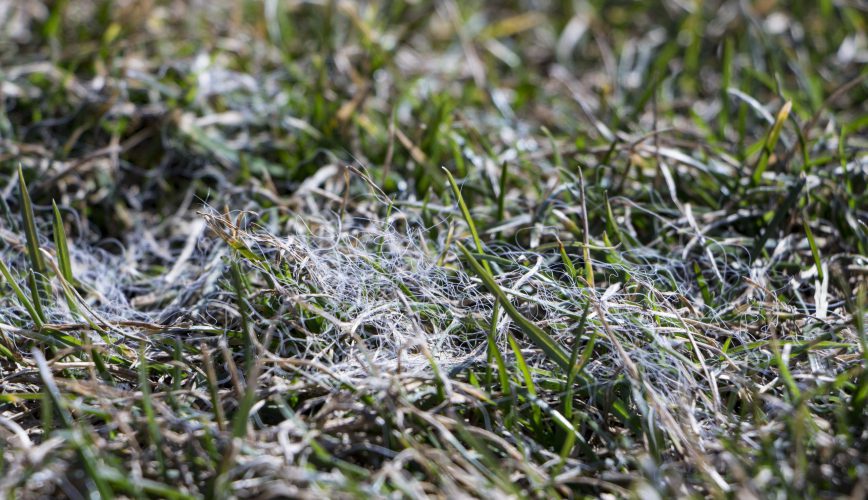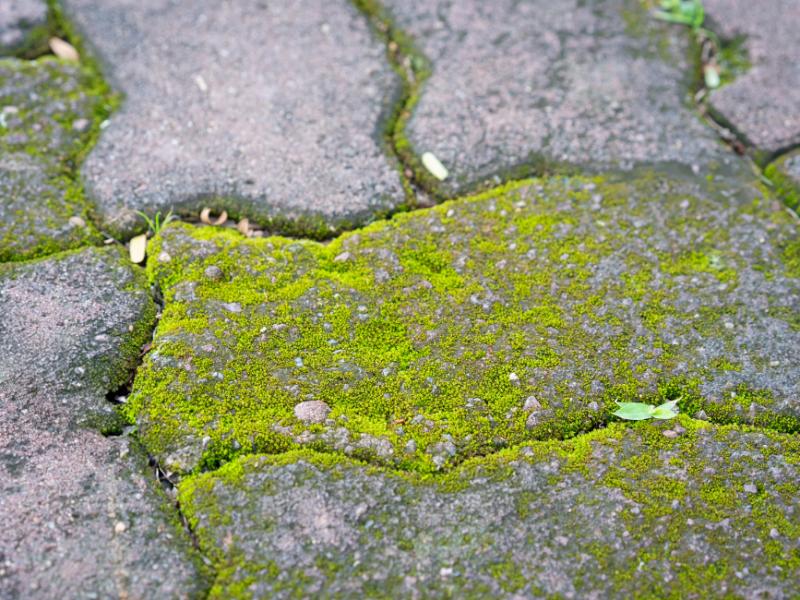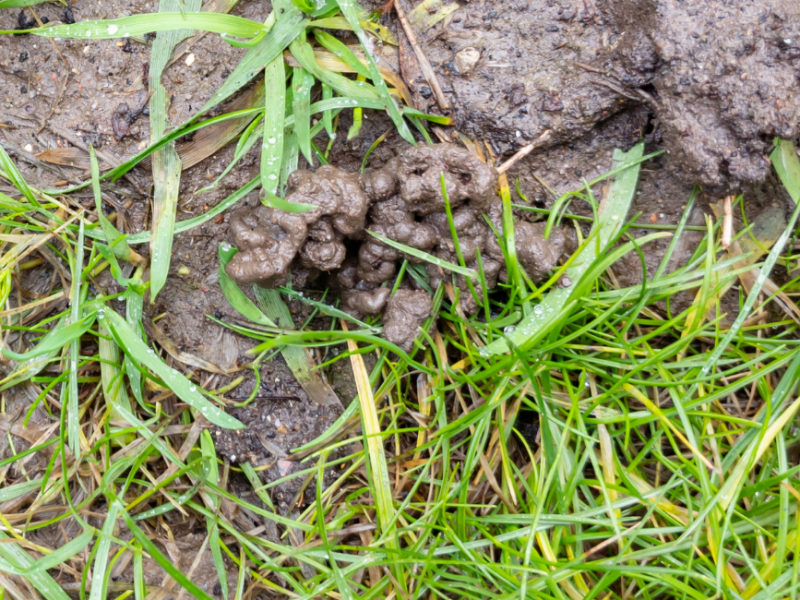You can take action to stop the spread of fungal diseases with effective treatments. Here is our guide to fungal threats and the best ways to eradicate them:
Types of Lawn Fungus
Fungi is prolific in lawns across the country. Though the majority are harmless, a few can cause your grass to become patchy and stunted. Ultimately endangering the wellbeing of your lawn.
It is essential to note what type of grass you may possess. As fine-leaved grasses are less hardy and can be more susceptible to disease than their ryegrass relatives.
The following are a few of the lawn fungus which could affect your lawn this Spring:
Leaf Blight
Leaf blight attacks and kills turfgrass leaves without destroying the structure of the turf itself. With the lawn bouncing back after the fungus has run its course. During the cold, damp Autumn and Winter months the leaf blight can become so severe it can kill your turf completely. Signs of the blight’s presence are yellowish-brown grasses and red, yellow and brown spots on the blades. The grass takes on a generally thin, unhealthy looking appearance.
Rust Disease
Rust disease is caused by massive numbers of airborne spores and affects most types of turfgrass. It is present in Spring or late Summer and early Autumn when the grass growth is slower. As well as during dry conditions where there is a deficit of nitrogen in the soil. Yellow patches and orange spore-producing fungi will be visible upon the leaves (and shoes if you walk on the lawn), turning black as Winter arrives.
Red Thread
Red thread causes a cottony russet fungus to appear on the blades of your grass. It is usually present where the soil is deficient in nitrogen, especially during wet Summers’ and Autumn, though it can develop at any time of year. Not typically fatal for the entirety of your lawn but is most acute on red fescue (Festuca rubra) grass types. Other fescues such as bents (Agrostis spp.), perennial ryegrass (Lolium perenne) and annual meadow grass (Poa annua) can also be affected. Resulting in light brown and bleached patches varying in size from 7.5cm (3in) to 25cm (10in) in diameter.
Anthracnose
Anthracnose blights lawns, foliage and other plants between April and November in damp or temperate weather. On lawns the spores are spread by mowing, meaning the best-kept grass is worst affected. The disease is characterised by patchy, discoloured spots without clear patterns. When looking closely at the grass blades, fine black strands are surrounded by brown and yellow rot. Annual meadow grass (Poa annua) and bentgrass (Agrostis stolonifera) are particularly susceptible.
Snow Mould
Snow mould is one of the most challenging lawn diseases. It causes brown and yellow patches on your grass, particularly in Autumn and mild periods during Winter. Patches can increase in size and reach 30cm (12in) or more in diameter, often merging and affecting large areas. During wet conditions, a white or pink cottony fungal growth can be seen. This is particularly troublesome for meadow grass (Poa annua) but can also affect bents (Agrostis), fescues (Festuca species) and perennial ryegrass (Lolium perenne).
Take-all Patch
Take-all patch is most common in bentgrass (Agrostis) during the Summer when the lawn is suffering drought conditions. It causes reddish patches and rings of grass, slowly turning brown over time. The size of the fungal patches can vary from 1-2cm up to 1m across, though the central sphere retains more hardy grasses like meadow grass (Poa annua). Ultimately roots will blacken and die, making the removal of the turf easier.
Brown Patch
Brown patch is an extremely destructive disease that spreads rapidly and damages large areas of the lawn. It lays dormant in Winter plant debris, infecting the lawn during mowing and attacking in the humidity of Summer, and can affect all types of grass. It first appears as circular brown patches, waterlogged and edged by waxy charcoal coloured rings ranging from a few inches to several metres.
Pythium Blight
Pythium blight is a fungal disease which infests all kinds of turfgrass. It is present in warm or cold weather, though its severity increases significantly during hot, humid seasons. Badly drained and poorly ventilated soil which retains damp is most at risk. Blades of grass appear waterlogged, darkened and greasy, beginning to wither and turn brown. It is also known as ‘cottony blight’ because of its cotton-like fungus growth, though streaks and runnels often form where the damp collects, further spreading the fungal spores.
Dollar Spot
Dollar spot occurs in Summer and Autumn; spores activate when temperates become warm and humid. Most often present in the cover of shade, where dew, inadequate irrigation and excess rain exacerbate the development of the disease. Aggressive mowing and poor soil nutrition add to the problem. American dollar-sized spots will become visible on the lawn, with a bleached appearance. These can be uneven, sunken or merge into one large area of yellow grass with tanned and reddish lesions on the blades. Bentgrass (Agrostis) and annual meadow grass (Poa annua) are most at risk.
Fairy Rings
Fairy rings are a collection of fungal fruiting bodies usually occurring in Summertime and growing up to 10m in diameter. Causing circles of toadstools and dead grass to appear on the lawn. They are not all harmful, depending on the type of fungi responsible, and are mostly spotted when toadstools begin to grow. Some of the only symptoms are a hoop of dead grass which expands across the turf, with adjacent grass lusher than usual and mushrooms at select times of the year.
Treatments
From time-to-time, your lawn will suffer from fungal disease or be exposed to environmental spores. That is why here at Greensleeves we offer a range of specialist treatments with which to help you control these diseases as and when they occur.
It is essential to follow a personalised turf maintenance programme to ensure your lawn is in the best health, ultimately reducing the continued likelihood and overall severity of such infestations. Our lawn treatment experts will first identify what your problem is and decide the best course of action. Some fungi may need a more aggressive treatment than others. We’ll assist you in choosing how to approach the problem and carry out the best treatments. Some of the most effective options are:
Fungicide
If a fungal disease has taken full control of your lawn, we can utilise an effective treatment with our expert fungicide formula to control the fungi and spores while preventing reinfection for up to 6 weeks.
Scarification
Scarification is a rigorous process best described as a mechanical raking of the lawn; its primary purpose is to remove thatch, although it has other associated benefits as well. The scarifying machine we use has a series of sharp tungsten blades which rotate at high speed and cut into the turf vertically. The depth can be easily adjusted to remove as much or as little thatch as required.
You will receive much more effective treatment with our intensive machine than you would by using a DIY tool.
Aeration
Hollow tine lawn aeration is the removal of small plugs from the lawn. This eases compaction and sub-surface thatch, allowing air, water and fertiliser to penetrate down to the root zone, particularly useful at the beginning and the end of the growing season. A lawn aerator can also help the lawn through drought stress conditions, enabling water retention in the central root zone.
Overseeding
Overseeding is one of the quickest and most effective ways to rejuvenate your lawn, the application of grass seed to replenish the old grass and fill in bare patches.
It is always provided in conjunction with either scarification or aeration, improving the lawn’s quality; increasing shade and drought tolerance while also enhancing your lawns resistance to future diseases.
Contact Us
If you think that your lawn is suffering from a suspected case of lawn fungus, it may be tempting to try and get rid of it yourself. While doing so may have short term effectiveness, there is a high chance it can come back and invade your lawn once more. The best way to help prevent the fungus from returning is to use our fungicide treatment and discuss your options with your local lawn care expert.
For more information about lawn fungus, browse our website or get in touch with us if you think you have a problem. Call us today on 0808 100 1413 or email us at [email protected].





